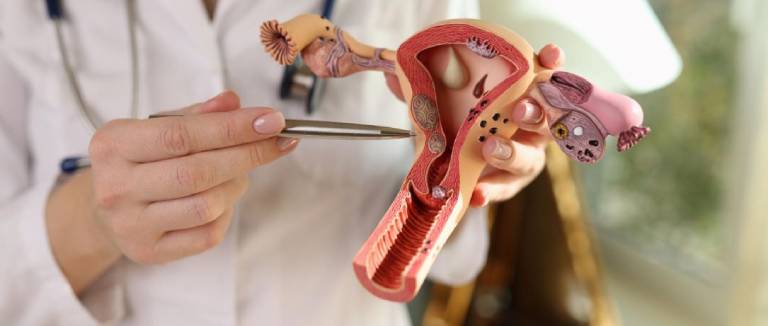Uterine Myoma Surgery: When It’s Needed and Fertility Considerations
Myomas, or fibroids, are benign tumors commonly found in women of reproductive age. Although often harmless, they can grow larger over time and lead to a range of health issues. Myoma surgery may be recommended to relieve symptoms, protect fertility, or prevent serious complications associated with these tumors.

What is Myoma Surgery?
Myomas are benign tumors that develop in the uterine wall and most commonly appear in women of reproductive age. While many fibroids are symptom-free, some can cause discomfort such as pelvic pain, a feeling of pressure, heavy menstrual bleeding, or frequent urination. Myoma surgery is a procedure to remove these tumors when they cause issues. Minimally invasive methods”such as laparoscopic and hysteroscopic surgery”are often preferred. These techniques use specialized instruments and cameras, resulting in less pain after surgery, quicker recovery, and smaller scars than traditional open surgery.
When is Myoma Surgery Required?
Myoma surgery is typically recommended for cases involving significant symptoms, fertility concerns, rapid tumor growth, severe pain, or other complications caused by uterine fibroids. The goal is to improve quality of life, address fertility issues, and prevent further health problems.
However, surgery is not always necessary. The decision depends on each individual's circumstances, symptoms, and a thorough evaluation by a healthcare professional. It's important for patients to work closely with their doctor to determine the most appropriate treatment plan for their specific needs.
Myoma Surgery Methods
The choice of myoma surgery technique depends on factors such as the size and location of the fibroids, the patient's overall health, and the goals of the treatment. Common surgical methods for myoma removal include:
Myomectomy (Myomectomy)
In myomectomy, only the fibroids are removed while the rest of the uterus remains intact. This approach is often recommended for women who wish to maintain their fertility, as it preserves the uterus and allows for the possibility of a natural pregnancy in the future.
Hysterectomy (Hysteroscopy)
In a hysterectomy, the entire uterus is surgically removed. This procedure is usually recommended when fibroids are especially large, numerous, or associated with severe health complications. It is important to note that pregnancy is no longer possible after a hysterectomy, as the uterus is no longer present.
Laparoscopic Surgery
Laparoscopic surgery is a minimally invasive technique in which fibroids are removed through a few small incisions using a specialized camera and surgical instruments. This approach typically results in smaller scars, less postoperative pain, and a quicker recovery compared to traditional open surgery.
Hysteroscopic Surgery
Hysteroscopic surgery involves removing fibroids using a specialized device inserted directly into the uterus. This minimally invasive technique is primarily used for fibroids located within the uterine cavity and typically results in less discomfort, a faster recovery, and minimal scarring.
Open Surgery
Open surgery involves removing fibroids through a large incision in the uterus. This approach is generally reserved for cases where fibroids are especially large or numerous.
Every surgical method has its own benefits and drawbacks. The best approach depends on each patient's unique condition. Before proceeding, the doctor will thoroughly evaluate your health and determine the most suitable surgical option.
Preparation Before Myoma Surgery
Proper preparation before myoma surgery is essential for a smooth procedure and recovery. Prior to surgery, your doctor will assess the size and location of your fibroids along with your overall health to develop the most suitable surgical plan.
Optimizing your health before the operation and closely following your doctor's instructions can greatly improve surgical outcomes and speed up your recovery. Thorough preoperative evaluation and following recommended precautions help ensure the success of your surgery and a faster healing process.

Recovery Process After Myoma Surgery
Recovery after myoma surgery depends on the surgical method, the patient's overall health, and the size of the fibroids. The general recovery steps include:
Regular follow-up appointments are crucial. Your doctor will assess your healing, monitor for issues, and help ensure your ongoing health after surgery.
Most patients spend several days in the hospital, where doctors monitor vital signs (blood pressure, pulse, and breathing) and watch for complications.
Pain control is a priority”your doctor will prescribe medication to help manage discomfort after surgery.
Proper care of your surgical scars and stitches is essential to lower infection risk. Always follow your doctor's instructions for wound care.
Initial rest is important, but gradually resuming gentle physical activity as recommended by your doctor can boost circulation and aid in healing.
A light, easily digestible diet and adequate fluid intake are usually recommended to support digestion and recovery.
Complaints After Myoma Surgery
Recovery time after myoma surgery varies between individuals and may take anywhere from a few weeks to several months, influenced by factors like your pre-surgery health, surgical complexity, and personal healing rate.
It is normal to experience some discomfort following surgery, such as pain, bleeding, bloating, gas, constipation, or fatigue”these usually resolve within a few days. If pain is persistent, bleeding increases, or new symptoms develop, contact your doctor promptly, as this may indicate a complication. Remember, feelings of distress can also be part of the recovery process and should improve as you heal.
Potential Risks of Myoma Surgery
Myoma surgery has no obvious risks. However, it is possible for risks to occur in every surgical operation. Risks that may occur in myoma surgery are:
- Bleeding may occur during or after surgery. Although the surgeon tries to control this, sometimes it cannot be controlled.
- There is a possibility of infection developing in the surgery area. Compliance with cleaning rules and the use of antibiotics can reduce the risk of infection.
- If general or epidural anesthesia is used, some complications may occur. These complications may include allergic reactions or breathing difficulties.
- It may damage surrounding tissues during surgical intervention. This is especially likely if the fibroids are large or very close to nearby tissues.
- Myoma surgery may bring some risks to pregnancy and fertility because it affects the uterus. This risk varies depending on the type of surgery and the patient's condition.
- Every patient is different, and risks may vary depending on the person's health condition, the size of the fibroids, and the complexity of the surgery.
* Liv Hospital Editorial Board has contributed to the publication of this content .
* Contents of this page is for informational purposes only. Please consult your doctor for diagnosis and treatment. The content of this page does not include information on medicinal health care at Liv Hospital .
For more information about our academic and training initiatives, visit Liv Hospital Academy
Frequently Asked Questions
Do myomas always require surgery?
Not always. Small or symptom-free fibroids may only need regular monitoring. Surgery is recommended when fibroids cause pain, bleeding, or fertility issues.
Can myoma surgery affect fertility?
Some surgical methods, such as myomectomy, are designed to preserve fertility. Your doctor will choose the most suitable option depending on your future pregnancy plans.
How long is the recovery period after myoma surgery?
Recovery time varies depending on the surgical method. Minimally invasive procedures may allow return to normal activities within 2 to 3 weeks, while open surgery may take longer.
Is myoma surgery painful?
Mild pain and discomfort are common after surgery but can be managed effectively with prescribed medications and rest.
Can myomas recur after surgery?
Yes, fibroids can recur even after successful surgery. Regular medical check-ups help detect and manage potential regrowth early.
When can I return to work after surgery?
Most patients resume light activities within a few weeks, depending on the procedure type and their healing progress.
Why choose Liv Hospital for myoma surgery?
Liv Hospital offers advanced minimally invasive surgical techniques, experienced specialists, and personalized care to ensure safe procedures and faster recovery.


